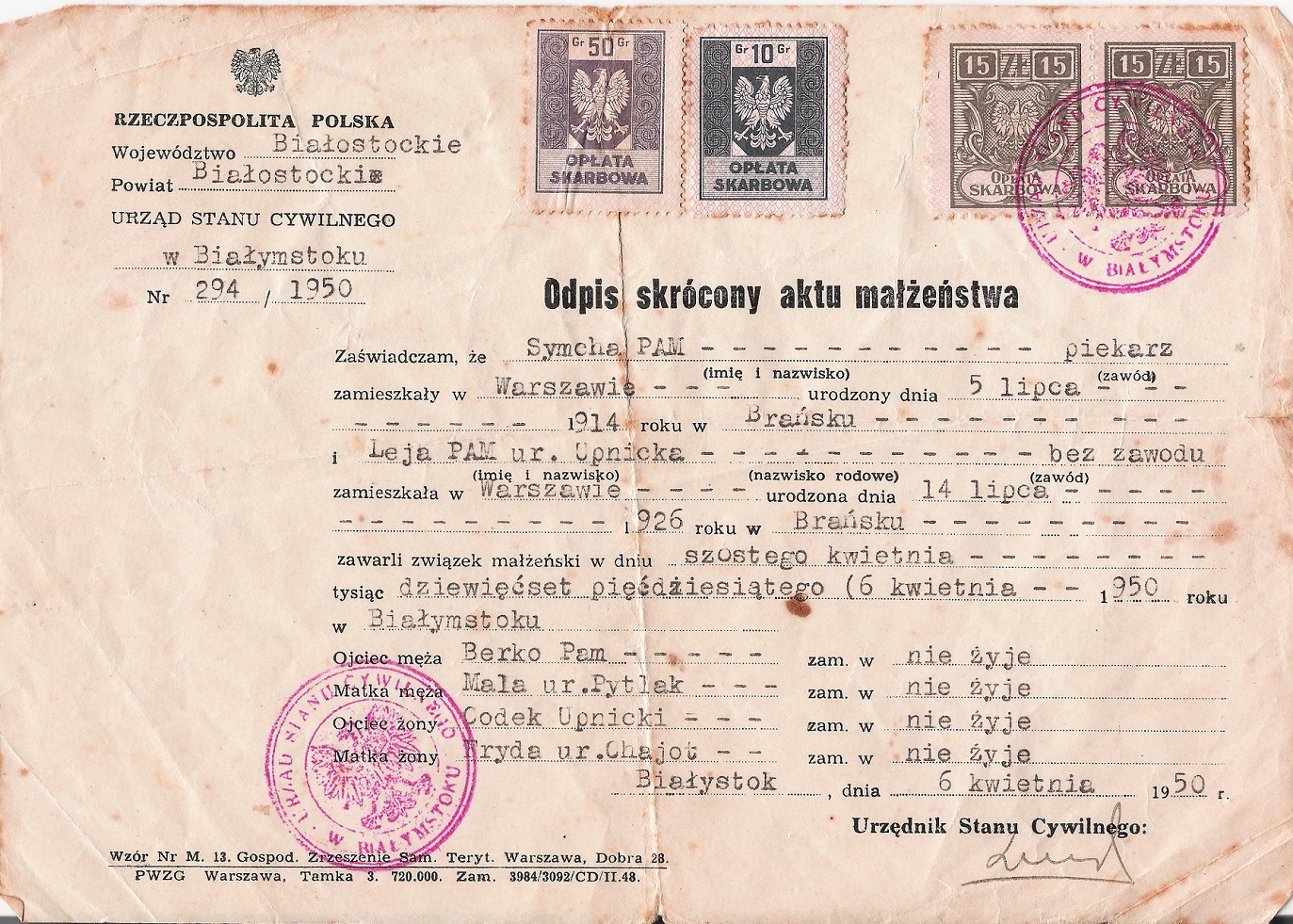Brańsk - Symcha Pam
1914 - 1990

Symcha Pam portfolio 5.7.1914-
23.01.1990:
Height: 168 cm
Eye color: Blue
Nationality: Jewish –
Polish.
Birthplace: Bransk, Poland – 5.7.1914.
Death place: Rehovot
Cemetery Israel, 23.1.1990.
Father: Berko/Berl Pam – 1871- ?
Mother:
Mala/Mali/Malka Pam of the house of Pytlak: 1873- 11.5.1931 (Bransk Poland)
Siblings:
about eight brothers with unknown names/location + one sibling who died at around the age of 6 from
drowning at a river while swimming.
Wife: Lea Pam of the house of Upnicki – 14.7.1926 –
23.05.2011.
Marriage date: 6.4.1950
Location of marriage: Bransk
Poland.
Daughter: Miriam Antwarg of the house of Pam –Born Warsaw Poland
18.9.1946-23.11.2007
Son: Dr. Zeev Pam – Born in Warsaw, Poland 01.09.1953 –
20.01.2013.
First name meaning: Symcha = is one of the words in the Hebrew language that
expresses Happiness. His name was given to him in the hope of better times than the time of his
birth, which was at the beginning of World war 1 (1914-1918).
Surname meaning: "Pam"
(Vilkomir, Belostok, Slutsk) O: abbreviation of הַמְדִינָה פַּרְנָס [Hebrew] community leader of the
province - A Dictionary of Jewish Surnames
from the Russian Empire: Revised Edition
by Dr. Alexander Beider - https://www.avotaynu.com/books/DJSRE2.htm
Symcha Pam was born to
a Jewish polish family in which the head of the family, his father Berko, had an oil grinding mill.
Since early childhood, Symcha learned in the Cheder/Yeshiva in the customary way of the Orthodox
Rabbinical Judaism as part of the Jewish kehillah of Bransk Poland.
Symcha grows up
with about eight other siblings. One of his siblings drowned while seaming in the river at the age
of 6 years old.
Symcha began learning the trade secrets of bakery and milling from his
father at around the age of 13 to make a living.
In 11.5.1931, his beloved mother, Mala
Pam of house Pytlak, died at the age of 58 from gastrointestinal cancer. Symcha and his siblings
created a large, massive tombstone in the Jewish cemetery in Bransk in her memory.
On her
tombstone it was written (translated from engraved Hebrew letter on her tombstone):
"Here
lies our mother, beloved in the prime of life, went to your grave. Oh, how lonely is the breakdown
of your sons. Lament at the departure of the dearest and modest woman, Mala Pam, daughter of Yakov.
She died 11th Shavuot of the year 5691. TNCBH"
Mali Pam`s gravestone was buried in the
ground and therefore survived the destruction caused to the Jewish cemetery in Bransk by the German
occupation.
With the German Nazi 3rd Reich occupation in world war 2 of Bransk Poland,
most of the Jewish community of Bransk was captured on 10.11.1942 and were sent to Ghetto Treblinka
extermination camp where the Jewish community was killed.
Symcha and two of his siblings
and some of their friends managed to escape the extermination camps and run away towards the forests
around Bransk Poland to join the Partisan resistance force. Symcha at that time was ranked: private
partisan forest fighter in forest Bransk battalion of Zhukov. There Symcha help smuggles people,
food, and possessions in and out of Treblinka concentration camp.
Symcha managed to
retrieve photos of his family and two sliver Shabbat candlesticks that belonged to the family before
the German occupation of Poland. (The original candlesticks are in the position of my family even
today).
During WW2, the Germans managed to be captured Symcha, but he escaped again and
again.
Most of Symcha`s extended family perished in Treblinka extermination
camps.
In 1945 after the end of WW2, Symcha went to Bialystok and raised a small factory
for the production of industrial oils. There he met Lea Upnicki later, his wife.
As far as
the story goes, the commonest confiscated the factory from Symcha, which led him to move to Warsaw
and became a road/dirt contractor.
Symcha`s address in Warszawa was Twarda Street Building
6 apartment 1 (basement level) – one of the few original buildings/synagogues to survive the
destruction.
In 1946 he Had his first-born daughter Mariam Pam
18.9.1946.
Officially Symcha and lea registered their wedding day at Bransk Poland at
6.4.1950.
Later in 1.9.1953, he had a second child, my father Zeev/ Wlodzimierz Pam
1.9.53.
In 12.1957, Symcha and his family decided to immigrate to Israel. They traveled to
Israel by ship.
In Israel Symcha and lea were part of the founder family that created the
Settlement known as Misgav Dov (Hebrew: מִשְׂגַּב דֹּב, lit. Dov`s Fortress), coordinates:
31°49′12.36″N 34°44′25.07″E
It is a moshav in south-central Israel. Located near Gedera in
the coastal plain, it falls under the jurisdiction of Gederot Regional Council. The moshav was
founded though the Mishkei Herut Beitar settlement movement by Herut members from Haifa in 1950. The
Settlement was named after Dov Gruner, a member of the Irgun who was executed by the British
authorities. The founders were later joined by new immigrants from Iraq, Poland, and the Soviet
Union.
In the Misgave Dov settlement, Symcha was working in
agriculture.
Symcha had a farm with horses cattle, chickens, duck and also grew
typical Israeli fruit trees, He worked and lived in Misgav Dov until 1977 due to deterioration of
his health care he sold his farm and moved to live in the city of Rehovot where he went to work in
original traditions of baking and milling industry and also worked in a Matzah
factory.
Symcha passed away due to lung disease in Kaplan hospital in Israel at
20.1.1990 and was buried in Rehovot cemetery Israel.
Symcha`s passing was mourned by
his children`s grandchildren, family community, and friends.
Credit Nadav
Pam nadavpam@gmail.com
2021-11-02 06:21:24 history
zeznanie Altera Trusa
2020-11-25 15:29:54









 uzupełnij jewishbialystok@gmail.com
uzupełnij jewishbialystok@gmail.com 




